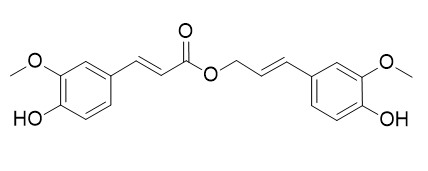Coniferyl ferulate
Coniferyl ferulate can inhibit Glutathione S-transferase activity in a concentration-dependent manner and show a potential MDR reversal effect for antitumour adjuvant therapy.
Inquire / Order:
manager@chemfaces.com
Technical Inquiries:
service@chemfaces.com
Tel:
+86-27-84237783
Fax:
+86-27-84254680
Address:
1 Building, No. 83, CheCheng Rd., Wuhan Economic and Technological Development Zone, Wuhan, Hubei 430056, PRC
Providing storage is as stated on the product vial and the vial is kept tightly sealed, the product can be stored for up to
24 months(2-8C).
Wherever possible, you should prepare and use solutions on the same day. However, if you need to make up stock solutions in advance, we recommend that you store the solution as aliquots in tightly sealed vials at -20C. Generally, these will be useable for up to two weeks. Before use, and prior to opening the vial we recommend that you allow your product to equilibrate to room temperature for at least 1 hour.
Need more advice on solubility, usage and handling? Please email to: service@chemfaces.com
The packaging of the product may have turned upside down during transportation, resulting in the natural compounds adhering to the neck or cap of the vial. take the vial out of its packaging and gently shake to let the compounds fall to the bottom of the vial. for liquid products, centrifuge at 200-500 RPM to gather the liquid at the bottom of the vial. try to avoid loss or contamination during handling.
Antioxidants (Basel).2022, 11(10):1929.
Allergol Immunopathol (Madr).2022, 1;50(4):23-30.
Kaohsiung J Med Sci.2023, 10.1002/kjm2.12764
Int J Mol Sci.2020, 21(19):7209.
Journal of Herbal Medicine2024, 48:100950
J Cell Mol Med.2023, 27(11):1592-1602.
Front. Plant Sci.2022, 13:757852.
J Phys Chem Lett.2021, 12(7):1793-1802.
Plant Physiol Biochem.2023, 201:107795.
Anat Rec (Hoboken).2021, 304(2):323-332.
Related and Featured Products
Planta Med. 2003 May;69(5):445-51.
Simultaneous analysis of seventeen chemical ingredients of Ligusticum chuanxiong by on-line high performance liquid chromatography-diode array detector-mass spectrometry.[Pubmed:
24058374 ]
Glutathione S-transferase (GST) is the key enzyme in multidrug resistance (MDR) of tumour.
Inhibition of the expression or activity of GST has emerged as a promising therapeutic strategy for the reversal of MDR.
METHODS AND RESULTS:
Coniferyl ferulate (CF), isolated from the root of Angelica sinensis (Oliv.) Diels (Radix Angelicae sinensis, RAS), showed strong inhibition of human placental GST. Its 50% inhibition concentration (IC50) was 0.3 μ M, which was greater than a known GSTP1-1 inhibitor, ethacrynic acid (EA), using the established high-throughput screening model. Kinetic analysis and computational docking were used to examine the mechanism of GST inhibition by CF. Computational docking found that CF could be fully docked into the gorge of GSTP1-1. The further exploration of the mechanisms showed that CF was a reversible noncompetitive inhibitor with respect to GSH and CDNB, and it has much less cytotoxicity. Apoptosis and the expression of P-gp mRNA were evaluated in the MDR positive B-MD-C1 (ADR+/+) cell line to investigate the MDR reversal effect of CF. Moreover, CF showed strong apoptogenic activity and could markedly decrease the overexpressed P-gp.
CONCLUSIONS:
The results demonstrated that CF could inhibit GST activity in a concentration-dependent manner and showed a potential MDR reversal effect for antitumour adjuvant therapy.
Evid Based Complement Alternat Med. 2013;2013:639083.
Coniferyl Ferulate, a Strong Inhibitor of Glutathione S-Transferase Isolated from Radix Angelicae sinensis, Reverses Multidrug Resistance and Downregulates P-Glycoprotein.[Pubmed:
24058374 ]
Glutathione S-transferase (GST) is the key enzyme in multidrug resistance (MDR) of tumour. Inhibition of the expression or activity of GST has emerged as a promising therapeutic strategy for the reversal of MDR.
METHODS AND RESULTS:
Coniferyl ferulate (CF), isolated from the root of Angelica sinensis (Oliv.) Diels (Radix Angelicae sinensis, RAS), showed strong inhibition of human placental GST. Its 50% inhibition concentration (IC50) was 0.3 μ M, which was greater than a known GSTP1-1 inhibitor, ethacrynic acid (EA), using the established high-throughput screening model. Kinetic analysis and computational docking were used to examine the mechanism of GST inhibition by CF. Computational docking found that CF could be fully docked into the gorge of GSTP1-1. The further exploration of the mechanisms showed that CF was a reversible noncompetitive inhibitor with respect to GSH and CDNB, and it has much less cytotoxicity. Apoptosis and the expression of P-gp mRNA were evaluated in the MDR positive B-MD-C1 (ADR+/+) cell line to investigate the MDR reversal effect of CF. Moreover, CF showed strong apoptogenic activity and could markedly decrease the overexpressed P-gp.
CONCLUSIONS:
The results demonstrated that CF could inhibit GST activity in a concentration-dependent manner and showed a potential MDR reversal effect for antitumour adjuvant therapy.



